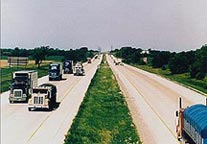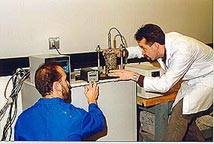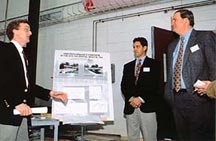U.S. Department of Transportation
Federal Highway Administration
1200 New Jersey Avenue, SE
Washington, DC 20590
202-366-4000
Federal Highway Administration Research and Technology
Coordinating, Developing, and Delivering Highway Transportation Innovations
|
Research & Technology Transporter This newsletter is an archived publication and may contain dated technical, contact, and link information. |
|
| Publication Number: N/A Date: March 1999 |
Publication Date: March 1999
|
Quantifiable methods for determining the bicycle compatibility of a roadway help engineers and planners make rational decisions about what specific roadway improvements will make a roadway safely accommodate bicyclists. Currently, there is no widely accepted methodology for determining how compatible a roadway is for bicyclists. FHWA's Safety Design Division has sponsored the development of a methodology called the Bicycle Compatibility Index (BCI).
Assessing the bicycle compatibility of a roadway involves determining how traffic operations and geometric conditions impact a bicyclist's decision to use or not use a specific roadway. The BCI incorporates variables bicyclists typically use in their assessments, such as traffic volume, vehicle speeds, and curb lane width.
The concept of users' perceptions of qualitative measures characterizing the operational conditions of a roadway is defined in the Highway Capacity Manual (HCM) as the Level of Service (LOS). (No LOS criteria for bicycles are given in the HCM.) Comfort, convenience, and freedom to maneuver, terms used in the HCM describing LOS, are applicable to bicyclists and are used in the BCI. The index number produced by quantifying the set of users' perceptions used in the BCI model can be used to establish an LOS for bicycling.
The BCI model can be used in a variety of applications:
Operational evaluations - The BCI can determine the bicycle LOS on existing roadways. The results of this evaluation can be used to produce bicycle compatibility maps; determine potential roadways for inclusion in a bicycle network, or target weak links in a bicycle network. The BCI also provides a way of evaluating alternative treatments such as adding a bicycle lane or removing parking.
Design - Designers can assess new roadways or roadways being re-designed to ascertain if they are compatible. Planned geometric features and predicted operational parameters can be input into the model. The resulting BCI index will indicate the bicycle LOS that can be expected. The BCI can be used to evaluate changes in the design necessary to improve the bicycle LOS.
Planning - The BCI model provides a mechanism to quantitatively define and assess long-range bicycle transportation plans. Using projected volumes and planned roadway improvements, long-range planning forecast data can be used to assess the bicycle compatibility of roadways in the future.
The results of this research effort are documented in two FHWA documents. The Bicycle Compatibility Index: A Level of Service Concept, Implementation Manual (FHWA-RD-98-095) and Final Report (FHWA-RD-98-72) which documents the entire research project. Excel workbooks of the BCI are available in both English and Metric units and can be downloaded from www.tfhrc.gov/safety/pedbike/research/current.htm.
Carol H. Tan (202) 493-3315 carol.tan@fhwa.dot.gov

One of the most prevalent safety issues concerning the long-haul trucking industry is a driver's alertness and fatigue. Long-haul drivers have varied schedules and may be on the road for several days or weeks at a time. In contrast, local/short-haul drivers typically engage in trips of 100 miles or fewer from their home base. The Office of Motor Carrier and Highway Safety has completed a focus group study that sought to determine the importance of fatigue in local/short-haul trucking operations. This research suggests that local/short-haul drivers are similar to workers of non-driving professions; fatigue is more likely a result of drivers' personal choices at home rather than of their work environment.
Researchers held 11 focus groups in the States of New Jersey, North Carolina, Pennsylvania, Virginia, and Washington. When drivers were given an opportunity to describe and discuss issues important to the local/short-haul industry, fatigue was raised as a safety issue in only 4 of the focus group sessions (36 percent).
Drivers gave several reasons why they believe fatigue is not as critical an issue for local/short-haul trucking as it is for long-haul trucking. Local/short haul drivers usually work during daylight hours, take work breaks that interrupt their driving, and end their shift at their home base.
Phase 2 of this project is now underway. Using instrumented vehicles, researchers are collecting direct, over-the-road observational data on driver fatigue and other driving safety issues concerning local/short-haul operations. Data on driver backing and lane-changing performance will also be collected.
The final report of the first phase of this study, Impact of Local/Short-Haul Operations on Driver Fatigue: Focus Group Summary and Analysis is available from the National Technical Information Service.
Bob Carroll
The Transportation Equity Act for the 21st Century (TEA-21) calls for a unique identifier for commercial motor vehicle (CMV) drivers. Among the options for identifiers is a biometric identifier. Biometric identifiers would ensure that CMV drivers were positively identified and would help prevent the issuance of multiple commercial driver licenses (CDLs) to a single driver. The Office of Motor Carrier and Highway Safety completed a study that reviewed the current status of biometric technologies to determine their ability to meet the needs of the CDL program. This research should aid those States that choose to implement a biometric identification system for CMV drivers.
A "biometric" technology is an automatic method that uses physiological or behavioral characteristics to identify an individual. This study considered all commercially available biometric systems, including signature verification, voice recognition, finger and palm prints, and iris and retinal scans.
Researchers determined that fingerprinting is the only available biometric technology that can currently meet all the functional requirements for a biometric identification system for CMV drivers. Using mathematical models, this research predicted that a two-finger system, which collects prints from two different fingers of each subject, would best ensure the positive identification, or identity verification, of CMV drivers.
The study suggests that fingerprinting be adopted as the standard biometric identifier. The study final report, Biometric Identification Standards Research, is available from the National Technical Information Service.
Phil Forjan

The Concrete Team of the Special Projects and Engineering Division has developed a standard test method and equipment with which to determine the thermal coefficient of expansion (T-coeff) of portland cement concrete (PCC). The development of this new equipment and test method allows engineers to determine the actual T-coeff for each specific concrete mixture rather than use an average value. This will further remove the guesswork from evaluating concrete mixtures.
The T-coeff of PCC, the rate at which concrete contracts and expands as temperature changes, is a critical element in pavement design. However, it is normally represented as an average value rather than a mixture-specific one. The value for T-coeff can vary significantly with the proportions of the mixture and the type of aggregate used. Using an average value to determine the T-coeff could lead to erroneous assumptions about a pavement's thermal response, resulting in possible distress of the concrete.
This test has been submitted to AASHTO for approval and is currently under consideration. In order for AASHTO to approve the test, AASHTO researchers must place both the specimen and the measurement frame in a water bath to allow for constant monitoring of the specimen length. Water is used as a heating or cooling medium.
Researchers are using this test method on a large set of pavement core samples that have been collected as part of the Strategic Highway Research Program and of FHWA's Long Term Pavement Performance (LTPP) investigations. The data collected on hundreds of these pavement cores from around the country will become part of the LTPP database and will be used to investigate the impact of the T-coeff of concrete on the response and long-term performance of pavements.
Stephen W. Forster (202) 493-3070 steve.forster@fhwa.dot.gov

Researchers in FHWA's Special Projects and Engineering Division Division and the University of New Hampshire (UNH) entered into a cooperative agreement to find uses for recycled materials that will reduce the cost of highway construction and materials. Funded by TEA-21, the agreement established a Recycled Materials Resource Center at UNH. The center will work closely with FHWA, State highway agencies, and academic researchers around the Nation to accelerate the development and implementation of recycled materials technology.
The center will research and test various technologies using recycled materials and will serve as a clearinghouse for information on the use of recycled materials in asphalt concrete, Portland cement concrete, granular base, embankment or fill, stabilized base, and flowable fill. By establishing the Recycled Materials Resource Center, researchers at UNH and FHWA have committed themselves to a long-term effort in this growing field of recycled materials research.
The center officially opened on November 6, 1998, under the direction of Dr. Taylor Eighmy. Director of FHWA Research, Development and Technology, Dennis Judycki, made remarks at the opening ceremony along with Senator Bob Smith and Congressman Charlie Bass of New Hampshire. Since the opening, the center has moved into new space on the university campus.
UNH and FHWA personnel have participated in the Great Lakes regional conference on recycled materials and gave a combined presentation of recent results and future efforts at the Transportation Research Board meeting in Washington, D.C. Efforts are also underway to conduct an international scan of recycling technology later in the year. For complete information about the center visit the following web site: www.unh.edu/RMCR.
Bob Kogler
The Office of International Programs hosted a team of South African engineers who were demonstrating new pavement technologies at the Transportation Research Board (TRB)'s 1999 Annual Meeting. The team demonstrated innovative equipment that measured pavement cracks as well as a multidepth deflectometer for road pavement deformations. The team presented two well attended seminars, one on pavement design techniques and the other on materials and equipment. Of particular interest to participants was a heavy vehicle simulator for testing pavements.
The team's participation and presentations at TRB are part of a long-term technology exchange program with the South African Ministry of Transport, South Africa's Council for Scientific and Industrial Research Technical exchange programs with South Africa have run more than 6 years, including an FHWA technology scanning tour of South African road technologies in 1996.
Al Logie (202) 366-9628 international@fhwa.dot.gov
TEA-21 exemplifies President Clinton's dedication to rebuilding America, improving safety, and protecting the environment. In a special session of the Transportation Research Board's 78th Annual Meeting held in January, transportation leaders agreed that building technology partnerships is the best way to achieve these objectives.

Section 5103 of TEA-21 calls for the USDOT to establish a national technology deployment initiatives and partnerships program (TDIPP). As the legislation indicates, the program's purpose is to significantly accelerate the adoption of innovative technologies by the surface transportation community. The special session, which highlighted several specific innovations, emphasized the power of technology partnerships to deliver tangible benefits to travelers and commercial users of the Nation's transportation system.
According to the experts who spoke at the session, technology partnerships between government and private sector entities are the key to closing the gap between the state-of-the-art and the state-of-the-practice in surface transportation. Dennis Judycki, Director of Research, Development, and Technology and moderator of the TRB special session, encouraged the more than 120 participants to support expanded partnerships as a key to adopting innovative technologies. FHWA Executive Director Anthony Kane described recent research, development, and technology planning activities designed to bring together the interests of transportation stakeholders from across disciplines and interests.
Partnerships among industry, academia, and State and Federal government will maximize increasingly scarce transportation funds, according to Gary Hoffman, Chief Engineer for the Pennsylvania Department of Transportation. The potential of advanced materials, such as high-performance concrete and steel and fiber-reinforced polymer composites, will extend infrastructure durability and reduce life-cycle cost.
Dr. Basav Sen of the USDOT's Volpe Center discussed the National Science and Technology Council Enhanced Transportation Weather Services Initiative, a partnership between the weather observation and transportation communities. The goal of the initiative is to make the best possible use of technological advances in weather observation and forecasting (such as Next Generation Radar and Advanced Weather Interactive Processing System) and in transportation infrastructure and vehicle design and operation (intelligent transportation systems, Vessel Traffic Services, global positioning systems) to provide timely, accurate, and usable weather information to traffic controllers, emergency managers, and ultimately to the users of the system.
Mr. Will Kirksey, Director of the Civil Engineering Research Foundation's Environmental Technology Evaluation Center (EvTEC), described the collaborative, market-based EvTEC program, which is designed to verify performance of environmental technologies and products.
Dr. Mark Edwards, Managing Director of the American Automobile Association's Traffic Safety Department, described new technologies for reducing the human costs of crashes. Dr. Edwards emphasized infrastructure and in-vehicle technologies that keep vehicles from leaving the road.
Safety is also critical for Richard Ashmore, President of Ashmore Brothers, Inc in Greer, South Carolina. Mr. Ashmore focused on new methods to reduce user delays and improve safety associated with constructing and maintaining surface transportation facilities.
In his closing remarks to the session, Dr. Fenton Carey of the USDOT's Research and Special Projects Administration reiterated the importance of partnerships, emphasizing USDOT's efforts to bring technology into the Department's overall strategy, to sharpen the focus on technology deployment, and to work with representatives of the transportation community to ensure an effective and efficient transportation system.
Bob Kelly

"Envision what can be, and work to make it so...." charged Rodney Slater, Secretary, U.S. Department of Transportation, to a receptive audience at the Transportation Research Board (TRB) Annual Meeting. Investing time and resources is vital, he advised, to translate visionary technology into plans of action. Linking transportation innovations to the needs of real people -- our customers -- stimulates economic development, personal mobility, and improved quality of life.
The projects and programs shown in the TRB exhibit halls reflect that focus -- displaying a synergy of customer focus and partnership throughout the array of innovative research, technology development and deployment activities. Over 80 booths featured technologies, programs and services sponsored by FHWA.
Several vehicles presented state-of-the-art technology for gathering and sharing data:
Training, education, and technology transfer programs of the National Highway Institute (NHI), Local Technical Assistance Program (LTAP) and the Garrett A. Morgan Technology & Transportation Futures Program demonstrated professional capacity building efforts for the present and future transportation community. A safety display on rumble strips, and presentations of the Woodrow Wilson Bridge and the Boston Artery projects highlighted outreach activities and consensus decision-making.
These examples of public participation, customer involvement, and streamlined operations illustrate programs and activities that will make a difference in transportation enterprise in the 21st century -- bringing good ideas into motion and skilled players into the action!
Martha M. Soneira martha.soneira@fhwa.dot.gov (202) 366-8029
In celebrating National Engineers Week this year, we recognize that engineering has been and will always be a necessary skill and critical function in FHWA. While we celebrate all the accomplishments the engineering profession can rightfully claim, let's also take the time to encourage young people to consider entering the engineering profession. They are the engineers of the future.
Much of the success of National Engineers Week is due to the commitment of individuals who take the opportunity during this period to reach out to students in their respective communities. Last year more than 40,000 engineers nationwide reached more than five million students and teachers through activities in kindergarten through twelfth grade classrooms.
This year's theme, "Engineers: Turning Ideas into Reality," says a lot about what engineers do for the Nation. As President Clinton said in a letter, "Since 1951, National Engineers Week has helped to increase public awareness and appreciation of the engineering profession and to celebrate the positive contributions engineers make to all aspects of our lives."
Dawn Vanlandingham (202) 493-3198 dawn.vanlandingham@fhwa.dot.gov